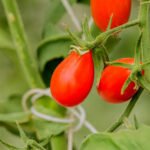The practice of incorporating flowers into vegetable gardens has become increasingly popular among garden enthusiasts and for good reason. Not only do these vibrant blooms add a splash of color and beauty to the garden, but they also offer a range of benefits that can enhance the overall growth and health of your vegetables.
In this blog post, we will delve into the many advantages of planting flowers alongside your veggies and provide a comprehensive list of flowers that are particularly suitable for vegetable gardens.
The integration of flowers in vegetable gardens serves multiple purposes that extend beyond aesthetic appeal. One key benefit is their ability to attract beneficial insects and pollinators. Bees, butterflies, and other pollinating insects are essential for fertilizing vegetable plants, ensuring successful fruit formation. By planting flowers that specifically attract these insects, you can create a thriving ecosystem within your garden that promotes pollination and boosts overall yields.
Additionally, introducing a variety of flowers into your vegetable garden helps foster biodiversity. The diverse array of plants attracts various beneficial organisms like ladybugs, lacewings, and hoverflies – all natural predators that help control common garden pests such as aphids and caterpillars. This natural pest control reduces the reliance on harmful chemical pesticides while providing a safe environment for both pollinators and vegetables.
Furthermore, certain types of flowers contribute to improving soil health by enhancing its structure and moisture retention capabilities. Deep-rooted flowers like marigolds penetrate compacted soil layers, loosening it up and improving drainage. Their roots also exude organic compounds that suppress harmful nematodes – microscopic worms known to attack plant roots. This added benefit creates an ideal growing condition for your vegetables.
With these significant advantages in mind, it’s clear why more gardeners are turning to flower-vegetable combinations in their gardens. In the following sections, we will explore the specific flowers best suited for vegetable gardens, their benefits, and how to incorporate them effectively. Let’s dig in and discover the world of flowers that can transform your vegetable garden into a vibrant and thriving oasis.
Why Flowers in Vegetable Gardens Can Enhance Growing Conditions
Attracting Beneficial Insects and Pollinators
One of the key reasons why flowers are beneficial in vegetable gardens is their ability to attract beneficial insects and pollinators. Many flowers, such as lavender, borage, and cosmos, produce nectar or pollen that attracts bees, butterflies, and other pollinators. These pollinators play a crucial role in the fertilization of vegetable plants, leading to better fruit set and yield.
Additionally, certain beneficial insects, like ladybugs and lacewings, feed on harmful pests that can damage vegetable crops. By planting flowers alongside vegetables, you can create an ecosystem that supports these beneficial insects and pollinators.
Promoting Biodiversity
Biodiversity is essential for maintaining a healthy garden ecosystem. By introducing a variety of flowers into your vegetable garden, you can increase biodiversity by providing different food sources and habitats for various organisms. Different flower species will attract different types of insects and wildlife, creating a more diverse ecosystem. This diversity helps to naturally control pests by attracting predators that feed on them. Moreover, it adds beauty to your garden with a range of colors and textures.
Improving Soil Health and Moisture Retention
Flowers also play a crucial role in improving soil health in vegetable gardens. Certain flowering plants have deep root systems that help break up compacted soil layers, improving its overall structure. Flowers like marigolds release organic matter into the soil as they decompose, enriching it with nutrients over time. Additionally, flowers assist in moisture retention by shading the ground beneath them from direct sunlight. This shade prevents excessive evaporation and helps keep the soil moist for longer periods between watering.
By understanding how flowers enhance growing conditions in vegetable gardens, you can make informed choices when selecting which flowers to include in your garden layout. From attracting beneficial insects and promoting biodiversity to improving soil health and moisture retention, flowers offer numerous benefits that can transform your vegetable garden into a thriving ecosystem.
Factors to Consider When Choosing Flowers for Vegetable Gardens
When choosing flowers to plant in your vegetable garden, there are several key factors you should consider. Taking these factors into account will help ensure that the flowers you choose not only enhance the aesthetic appeal of your garden but also provide maximum benefits to your vegetables.
- Climate and Regional Conditions: The first factor to consider is the climate and regional conditions of your area. Different flowers thrive under specific temperature and environmental conditions. Research which flowers are best suited for your region’s climate and choose accordingly. This way, you can ensure that the flowers will grow well alongside your vegetables and contribute positively to their overall health.
- Flower Types that Complement Specific Vegetables: Another important consideration is selecting flower types that complement specific vegetables in your garden. Some flowers have natural symbiotic relationships with certain vegetables, providing them with additional benefits like repelling pests or attracting pollinators. For example, planting marigolds near tomatoes can help deter pests such as aphids. Zinnias are known to attract pollinators and make great companions for beans.
- Height, Spread, and Compatibility: Lastly, it’s crucial to choose flowers that have compatible growth habits with your vegetables in terms of height and spread. Taller flowers like sunflowers can provide shade for delicate vegetables during hot summer months, while low-growing flowers like nasturtiums make excellent ground cover options. Additionally, considering compatibility in terms of nutrient requirements and soil preferences can also contribute to a successful combination of flowers and vegetables in your garden.
By carefully considering these factors when choosing flowers for your vegetable garden, you can create a harmonious environment where both plants thrive together, promoting optimal growth and health for all.
Marigolds
Marigolds are a staple in every vegetable garden for good reason. Not only do they add vibrant pops of color, but marigolds also have numerous benefits for your vegetable plants. One of the main advantages of planting marigolds in your vegetable garden is their ability to repel pests and nematodes. These pesky invaders can wreak havoc on your precious crops, but marigolds act as a natural deterrent.
There are various varieties of marigolds to choose from, each with its own advantages. French marigolds, for example, produce a strong scent that repels pests like aphids and whiteflies. On the other hand, Mexican marigolds contain natural chemicals that discourage nematodes from harming your vegetables’ roots. By incorporating different types of marigolds into your vegetable garden, you can create an effective defense system against common plant pests.
When it comes to planting and caring for marigolds in your vegetable garden, there are a few things to keep in mind. Marigold seeds can be started indoors or directly sown into the ground after the threat of frost has passed. They thrive in full sun and well-drained soil, so make sure to provide them with the ideal growing conditions. Additionally, deadheading spent flowers will promote continuous blooming throughout the season.
Overall, adding marigolds to your vegetable garden not only enhances its visual appeal but also provides protection for your plants against pests and nematodes. With their bright blooms and incredible benefits, marigolds truly are a must-have flower for every vegetable garden.
- Consider starting this section with an introductory sentence or paragraph that introduces the topic of this section (marigold flowers) as one of the recommended flowers for vegetable gardens.
- Use an unordered list to highlight key benefits of marigold flowers in vegetable gardens.
- Use subheadings or bold text within the section to distinguish between different aspects of marigolds in vegetable gardens (e.g., benefits, varieties, planting and care tips).
Nasturtiums
Nasturtiums are a fascinating flower that not only adds beauty to vegetable gardens but also serves dual purposes. These vibrant flowers are known for their stunning colors, ranging from bright yellows and oranges to deep reds and purples. However, beyond their visual appeal, nasturtiums offer practical benefits for both the garden and the kitchen.
One of the key advantages of having nasturtiums in a vegetable garden is their ability to attract beneficial insects while deterring pests. The bright blooms of nasturtiums act as beacons for pollinators such as bees and butterflies, which play a crucial role in the fertilization of vegetables. Additionally, nasturtiums emit a pungent scent that repels pests like aphids and whiteflies, helping to protect neighboring vegetables from infestation.
What sets nasturtiums apart from other flowers is their edibility. Both the flowers and leaves of nasturtium can be used in culinary creations, adding a unique peppery flavor to dishes. The vibrant petals make beautiful additions to salads, providing color and a hint of spice. Nasturtium leaves can also be used as an alternative to traditional salad greens or incorporated into pestos for added zest.
To maximize the benefits of nasturtiums in a vegetable garden, it is important to properly care for them. These flowers thrive in full sun or partial shade and prefer well-draining soil. Directly sow nasturtium seeds into the ground after all risk of frost has passed or start them indoors before transplanting outside. Water regularly but avoid overwatering as excessive moisture can lead to diseases.
Nasturtiums are undoubtedly valuable additions to any vegetable garden due to their dual purpose as both an attractive flower and an edible plant. By planting these colorful blooms alongside your vegetables, you can enhance the aesthetic appeal of your garden while promoting pollination and repelling pests. Furthermore, the option to incorporate nasturtiums into your culinary endeavors adds a creative twist to your meals. So why not consider adding some nasturtiums to your vegetable garden this growing season?
| Nasturtium Benefits | Notes |
|---|---|
| Attracts beneficial insects | Nasturtiums act as beacons for pollinators like bees and butterflies. |
| Deters pests | The pungent scent of nasturtiums repels aphids and whiteflies. |
| Edible flowers and leaves | Nasturtium petals add color and flavor to salads, while leaves can be used in various dishes. |
Calendula
Introduction to Calendula
Calendula, also known as Pot Marigold, is a beautiful and vibrant flower that has been valued for centuries for both its aesthetic appeal and medicinal properties. This flowering plant is not only a great addition to any garden but also offers numerous benefits for both the garden and the body. In this section, we will delve into the various reasons why calendula is an excellent choice for vegetable gardens.
The Bright and Cheerful Blooms of Calendula
One of the most appealing aspects of calendula is its bright, cheery blooms. The flowers come in various shades of yellow and orange, adding a pop of color to your vegetable garden. These eye-catching blossoms not only create an attractive visual display but can also attract pollinators such as bees and butterflies. By inviting these beneficial insects into your garden, you are increasing the chances of pollination for your vegetables and promoting biodiversity.
The Medicinal Properties of Calendula
In addition to its visual appeal, calendula possesses remarkable healing properties that have been recognized since ancient times. The petals of calendula flowers contain compounds with anti-inflammatory and antimicrobial effects. This makes calendula a popular ingredient in herbal remedies, skincare products, and even culinary preparations.
When it comes to skincare, calendula can be used in creams or ointments to soothe various skin irritations such as rashes or minor burns. Its anti-inflammatory properties help reduce redness and swelling while promoting faster healing. Furthermore, calendula’s gentle nature makes it suitable for sensitive or dry skin.
Beyond skincare, calendula has also been used internally for its potential health benefits. It can be brewed into a tea with mild flavor or added as an ingredient in dishes like salads or soups. Both traditional medicine practitioners and modern herbalists believe that consuming calendula may support digestion, boost the immune system, and relieve menstrual discomfort.
Calendula’s healing properties extend beyond our bodies and into the garden as well. It has been observed that calendula can attract beneficial insects like ladybugs and lacewings, which are natural enemies of common garden pests such as aphids or mites. As a result, growing calendula in your vegetable garden can provide a natural form of pest control while promoting a thriving ecosystem.
Sunflowers
Sunflowers are a popular choice for adding height, shade, and beauty to vegetable gardens. Their striking appearance and impressive height make them a standout feature in any garden. In addition to their aesthetics, sunflowers offer several benefits when planted alongside vegetables.
One benefit of planting sunflowers in vegetable gardens is that they provide shade during the hot summer months. This shade can be particularly helpful for delicate vegetables that may wilt or suffer from heat stress. By strategically planting sunflowers around these vulnerable plants, you can create a natural canopy that helps to regulate temperatures and protect them from the scorching sun.
Another advantage of having sunflowers in your vegetable garden is their ability to attract beneficial birds and pollinators. Sunflower heads contain an abundance of nutritious seeds that are irresistible to many bird species, such as finches and sparrows.
These birds not only add beauty and animation to your garden but also help control pests by feeding on insects that may pose a threat to your vegetables. Additionally, the bright yellow flowers of sunflowers act as beacons for bees and other pollinators, increasing the chances of successful pollination in your vegetable plants.
To make the most out of incorporating sunflowers into your vegetable garden, consider planting different varieties with varying heights and bloom times. This will ensure a continuous display of color throughout the growing season and provide different levels of shade for various vegetables. Some popular varieties include the giant Russian Mammoth sunflower, which can reach up to 12 feet tall, and the Dwarf Sunspot variety, which grows up to 2-3 feet tall.
| Benefit of Sunflowers in Vegetable Gardens | Example |
|---|---|
| Providing shade for delicate vegetables during hot summer months | Creating a natural canopy that helps regulate temperatures and protect plants from heat stress. |
| Attracting beneficial birds and pollinators to the garden | Birds feeding on sunflower seeds help control pests, while bees and other pollinators are attracted to the bright yellow flowers, increasing successful pollination. |
| Variety of heights and bloom times | Selecting different sunflower varieties ensures a continuous display of color throughout the growing season and provides varying levels of shade for different vegetables. |
Recommended Flower Combinations for Specific Vegetables
In order to maximize the benefits of incorporating flowers in your vegetable garden, it is important to choose flower-vegetable combinations that complement each other and promote healthy growth. Here are some recommended flower combinations for specific vegetables:
- Zinnias with Tomatoes: Zinnias are known for attracting pollinators and beneficial insects, while tomatoes benefit from the presence of these pollinators for fruit production. The vibrant colors of zinnias also add a visually pleasing element to the tomato plants.
- Cosmos with Beans: Cosmos flowers attract pests such as aphids away from beans, effectively acting as a natural repellent. Additionally, cosmos are tall and can provide shade to the delicate bean plants during hot summer months.
- Nasturtiums with Cucumbers: Nasturtiums have been proven to repel pests like aphids and cucumber beetles, which can be detrimental to cucumber plants. These colorful flowers also add a touch of beauty to the vegetable garden.
- Borage with Squash: Borage flowers are highly attractive to bees and other pollinators, benefiting both borage and squash plants by increasing their fruit set. Furthermore, borage has deep roots that improve soil health by loosening compacted soil.
- Marigolds with Brassicas (Cabbage, Broccoli, Kale): Marigolds are well-known for their ability to repel pests such as nematodes and cabbage worms that commonly attack brassica crops. Planting marigolds alongside brassicas can help protect them against these pests naturally.
When selecting flower-vegetable combinations, keep in mind factors such as compatibility, height, and spread of both plants. Ensure that the flowers will not overshadow or compete with the vegetables for resources such as sunlight or water. It is also important to consider regional conditions and climate suitability when choosing flower varieties for your vegetable garden.
By incorporating these recommended flower combinations, you can enhance the growth and overall health of your vegetables. The strategic placement of flowers can attract beneficial insects, repel pests, improve soil health, and provide shade or support for delicate plants. Start experimenting with flower-vegetable combinations in your garden today and reap the benefits of a beautiful and bountiful harvest.
Conclusion
In conclusion, incorporating flowers in your vegetable garden can bring a multitude of benefits to your growing space. By attracting beneficial insects and pollinators, flowers contribute to the overall health and productivity of your vegetable plants. The biodiversity that flowers bring also helps maintain a balanced ecosystem, improving soil health and moisture retention.
When choosing flowers for your vegetable garden, it’s important to consider your climate and regional conditions. Certain flower types complement specific vegetables well, and their height, spread, and compatibility with vegetables should also be taken into account.
Among the recommended flowers for vegetable gardens, marigolds stand out as a must-have. These vibrant flowers not only add beauty to your garden but also repel pests and nematodes that can harm your crops. Nasturtiums are another excellent choice, with their edible flowers serving as both a visual delight and a natural pest deterrent. Calendula is not only beautiful but also offers healing properties for both the garden and the body, attracting pollinators while soothing the skin.
In addition to these flower options, sunflowers provide height, shade, and beauty to any vegetable garden. Their striking appearance adds visual interest while providing shade for delicate vegetables during hot summer months. Sunflowers also attract beneficial birds and pollinators to the garden.
So why wait? Start enhancing your vegetable garden with flowers today. Incorporating flowers will not only improve the aesthetics of your garden but also contribute to healthier plants and increased yields. Explore the suggested flower options mentioned in this article and create a vibrant space that benefits both you and nature. With just a little effort in planting flowers alongside your vegetables, you can reap the rewards of a flourishing garden filled with color, fragrance, beneficial insects, and abundant harvests.
Frequently Asked Questions
What are the best flowers to plant in a vegetable garden?
When it comes to choosing flowers to plant in a vegetable garden, it is important to select varieties that can provide specific benefits. Marigolds are often considered the best flowers to plant in a vegetable garden due to their ability to repel certain pests, like nematodes. Their bright orange and yellow blooms not only add a vibrant touch to the garden but also serve as natural insect repellents.
Additionally, Nasturtiums are another great choice as they can deter aphids and caterpillars while attracting pollinators with their vibrant blooms. Calendula is another flower often recommended for vegetable gardens as it attracts beneficial insects like ladybugs and lacewings, which help control harmful pests.
What flowers and vegetables grow well together?
Certain flowers and vegetables can be excellent companions in a garden as they offer mutual benefits when planted together. For example, marigolds and tomatoes are known to have a favorable relationship as marigolds can help protect tomatoes from harmful nematodes.
Similarly, basil is often recommended to be planted alongside tomatoes, peppers, or lettuce as it deters some pests that tend to affect these vegetables. Another great pairing is planting zinnias alongside cucumbers, squash, or melons since they attract pollinators that enhance fruit production.
What flowers should not be planted near vegetables?
While companion planting can bring numerous advantages in the garden, there are certain flowers that should not be planted near vegetables due to potential negative effects on growth or pest attraction. For instance, sunflowers should not be planted near potatoes since they can compete for water and nutrients with the potato plants.
Similarly, dill should be kept away from carrots since it has been observed that planting them together may lead to stunted growth of both plants. Additionally, it is generally recommended to avoid planting vegetables near plants from the mustard family (such as cabbage or broccoli) since they release chemicals that can inhibit growth in neighboring plants.

If you’re looking to get into vegetable gardening, or are just looking for some tips on how to make your current garden better, then you’ve come to the right place! My name is Ethel and I have been gardening for years. In this blog, I’m going to share with you some of my best tips on how to create a successful vegetable garden.





